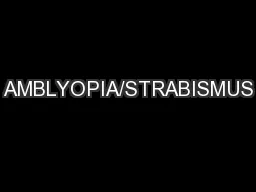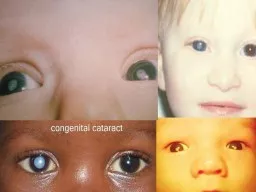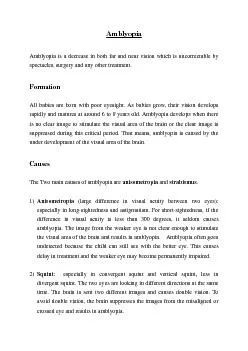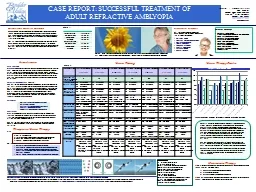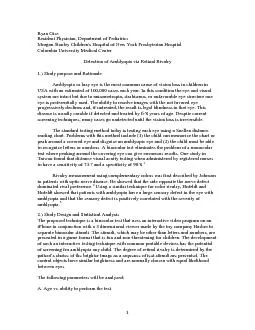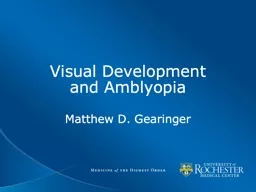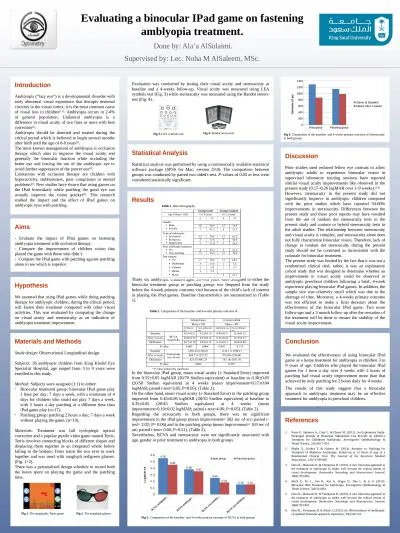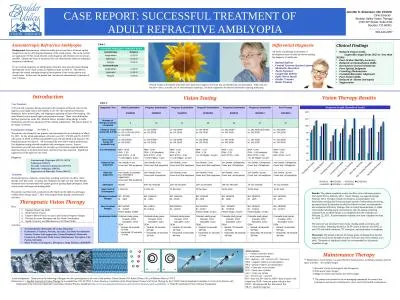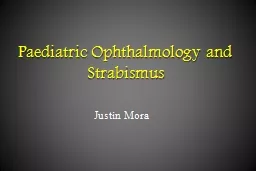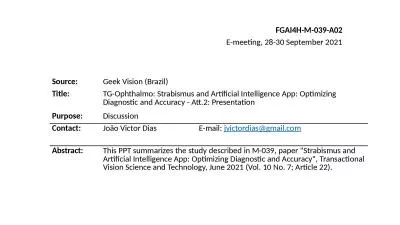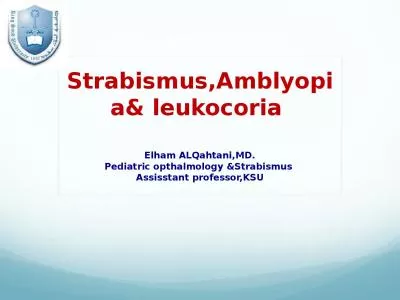PPT-AMBLYOPIA/STRABISMUS
Author : phoebe-click | Published Date : 2016-07-18
KEHINDE A V MBBS FWACS FICS Senior Ophthalmic Surgeon Amblyopia refers to a decrease of vision either unilaterally or bilaterally for which no anatomical cause
Presentation Embed Code
Download Presentation
Download Presentation The PPT/PDF document "AMBLYOPIA/STRABISMUS" is the property of its rightful owner. Permission is granted to download and print the materials on this website for personal, non-commercial use only, and to display it on your personal computer provided you do not modify the materials and that you retain all copyright notices contained in the materials. By downloading content from our website, you accept the terms of this agreement.
AMBLYOPIA/STRABISMUS: Transcript
KEHINDE A V MBBS FWACS FICS Senior Ophthalmic Surgeon Amblyopia refers to a decrease of vision either unilaterally or bilaterally for which no anatomical cause can be found TERMINOLOGIES. Bonneh a Dov Sagi Uri Polat Department of Neurobiology Brain Research The Weizmann Institute of Science Rehovot 76100 Israel Goldschleger Eye Research Institute TelAviv University Sheba Medical Center Tel Hashomer 52621 Israel Received 18 July 200 Opacity in lens. Can be: Visually significant or not. Stable or Progressive. Congenital or Acquired. Unilateral or Bilateral. Partial or Complete. Amblyopia amblyopia is around 2-4%. It rarely Prevention The most important preventivthe causes of amblyopia such as anisometropia and squint. Prompt treatment and strict adherence to the treatment pr lesion in an . infant. PICTURE QUIZ. BMJ 28 . November 2011. د. حسين محمد . جمعه . اختصاصي الامراض الباطنة . البورد العربي . كلية طب الموصل . Jennifer . S. Simonson, OD, FCOVD. . Clinic Director . Boulder Valley . Vision Therapy. 1790 30. th. Street, Suite #. 311. . Boulder, CO 80301 . www.bouldervt.com. 303-443-2257. A . 35-year-old Caucasian female presented with symptoms of blurred vision in the right eye, poor night vision, and . T. Guthoff. Vorlesung Strabologie. Lernziele. Erinnerung: Anatomie und Physiologie. Was ist Amblyopie?. Was ist der Unterschied zwischen latenten und manifestem Schielen?. Was ist der Unterschied zwischen kindlichem Begleitschielen und paretischem Schielen?. 1 Ryan Gise Pediatrics Morgan Stanley Children's Hospital of New York Presbyterian Hospital Columbia University Medical Center Detection of Amblyopia via Retinal Rivalry 1.) Study purpose and Rational Matthew D. Gearinger. Goal. To review the clinical significance and evidence-based treatments of amblyopia.. Learning Objectives. List the three major etiologies of amblyopia.. Outline the evidenced-based treatment options for amblyopia.. .. . Done by: Ala’a AlSulaimi.. Supervised by: Lec. Noha M AlSaleem, MSc.. References. . Knox . P.. , Simmers . A.. , Gray . L.. & Cleary M.. (2012). . An Exploratory Study: Prolonged Periods of Binocular Stimulation Can Provide an Effective Treatment for Childhood Amblyopia. Jennifer . S. Simonson, OD, FCOVD. . Clinic Director . Boulder Valley . Vision Therapy. 1790 30. th. Street, Suite #. 311. . Boulder, CO 80301 . www.bouldervt.com. 303-443-2257. A . 35-year-old Caucasian female presented with symptoms of blurred vision in the right eye, poor night vision, and . . Justin Mora. Paediatric Ophthalmology. Key . problems . in . Paediatric. Ophthalmology. Assessing . vision in children. Assessing strabismus. Types of strabismus. Management of . strabismus. Nasolacrimal Duct Obstn. Information Sheet Amblyopia (A Lazy Eye) We are committed to making our publications as accessible as possible. If you need this document in an alternative format, for example, large print, Braille Source:. Geek Vision (Brazil). Title:. TG-. Ophthalmo. : Strabismus and Artificial Intelligence App: Optimizing Diagnostic and Accuracy - Att.2: Presentation. Purpose:. Discussion. Contact:. João Victor Dias. leukocoria. . Elham . ALQahtani,MD. .. Pediatric . opthalmology. &Strabismus . Assisstant. . professor,KSU. Strabismus . ocular misalignment .. 2%-3% of children and young adults.. Male=Female.
Download Document
Here is the link to download the presentation.
"AMBLYOPIA/STRABISMUS"The content belongs to its owner. You may download and print it for personal use, without modification, and keep all copyright notices. By downloading, you agree to these terms.
Related Documents

